Seeing the city from all sides of the Middle Sea

By Felicity Ratté
Art history professor Felicity Ratté spent her sabbatical last year traveling and expanding on her research regarding medieval urban design around the Mediterranean.
Although my research focuses on the monumental centers of cities in medieval Italy, during my sabbatical I turned my analytical lens on the same sites in key cities of the Islamic world. I was looking for correspondences between approaches to architecture that emphasized the role of monumental sites in civic rituals. In particular, I examined attention to scale, site, architectural detailing or particular features that were designed to be seen either in passing—as one walked by a building during a procession—or as one stood before a building while something happened within or in front of it.
This research was motivated by a sense that the public discourse that now describes the interaction between Europe/America and the Islamic world as a “clash of civilizations” erases the historic fact of cultural interdependence. I set out to look for evidence of this interdependence in the built environment of North Africa, the Middle East and Turkey from the 14th century, the period I study in Italy. The particular focus of this analysis was both monumental building types, such as mosques, madrasas (schools) and mausolea, and urban design practice such as the layout and location of fountains, souks (markets) and public space.
In the cities of the Islamic Mediterranean, I found much evidence of architectural design that was powerfully influenced by the symbolic role that buildings play for the urban population. I have begun now to understand how this influence can be productively compared to what was going on in Italy at the same time.
Although my work has only just begun, and there is still much that I need to do in order to justify this type of comparative study, I have come closer to understanding the multiple and highly complex models of urban practice, design and use in the Islamic world. In addition, from Tangiers to Kayseri, I was privileged to encounter spontaneous and ritual acts of kindness, sympathy and welcome that reinforced my impression of cultural concurrence and enriched my research in ways that are beyond measure.
 Colonial scholars erroneously maintained that there was little evidence of urban design in Islamic cities; any apparent evidence was considered inferior to what the Muslims inherited from classical cities. I found a perfect example of this error in Damascus, a Roman, then Byzantine city taken by the Arabs in 636 CE. Here you see the remains of the western propylaeum that leads up to the former Temple of Jupiter, which was transformed into the Great Mosque of Damascus in 706. The careful transformation of Damascus into an Islamic capital confirms the presence of sophisticated urban design practices.
Colonial scholars erroneously maintained that there was little evidence of urban design in Islamic cities; any apparent evidence was considered inferior to what the Muslims inherited from classical cities. I found a perfect example of this error in Damascus, a Roman, then Byzantine city taken by the Arabs in 636 CE. Here you see the remains of the western propylaeum that leads up to the former Temple of Jupiter, which was transformed into the Great Mosque of Damascus in 706. The careful transformation of Damascus into an Islamic capital confirms the presence of sophisticated urban design practices.
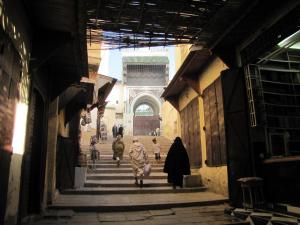 Contrary to colonialist and even modern media preconceptions, I found similarities in urban design and use between Italy and the Islamic Mediterranean. In Fez, for example, I found evidence of processional activity that purposefully linked different sections of the city together, such as this procession for the Festival of Moulay Idris (below). This connection is a noteworthy phenomenon found in Italy as well. The monumental portal of the Andalusian mosque (above) markedly distinguishes the building from the rest of the buildings around it, suggesting a hierarchy of structures that could be read from the street.
Contrary to colonialist and even modern media preconceptions, I found similarities in urban design and use between Italy and the Islamic Mediterranean. In Fez, for example, I found evidence of processional activity that purposefully linked different sections of the city together, such as this procession for the Festival of Moulay Idris (below). This connection is a noteworthy phenomenon found in Italy as well. The monumental portal of the Andalusian mosque (above) markedly distinguishes the building from the rest of the buildings around it, suggesting a hierarchy of structures that could be read from the street.
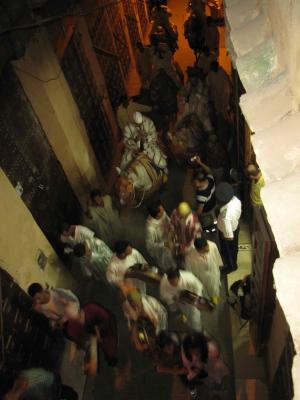
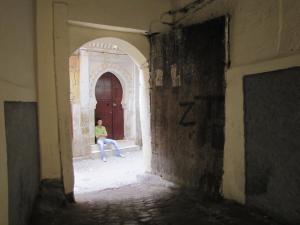 I found some architectural details of Islamic cities that were very different from what existed in Italy. For example, a very interesting feature common to many of the cities I studied is interior gates, such as the examples here from Fez (above) and Tunis (below). These gates could be closed to reroute traffic or for enhanced security. Despite these differences, however, the principles of urban iconography—the style of built elements as well as their siting—are strikingly similar to those found in medieval cities of Italy.
I found some architectural details of Islamic cities that were very different from what existed in Italy. For example, a very interesting feature common to many of the cities I studied is interior gates, such as the examples here from Fez (above) and Tunis (below). These gates could be closed to reroute traffic or for enhanced security. Despite these differences, however, the principles of urban iconography—the style of built elements as well as their siting—are strikingly similar to those found in medieval cities of Italy.
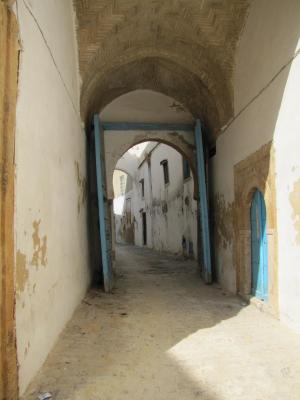
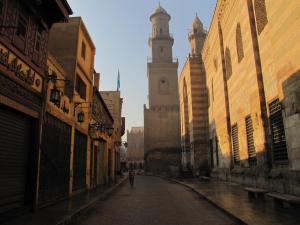 The city in which I found the most, and most remarkable, correspondences with what I know of in Florence was Cairo, historic capital of the Mamluk dynasty. Here you can see, for example, the similarities between Cairo’s Bayn al Qasrayn (above) and Florence’s Piazza della Signoria (below). Monumental architectural complexes in Cairo, such as the mosque, madrasa and mausoleum of Sultan Qalawun (c. 1284), were designed as backdrops to civic rituals, just as churches and public palaces were in Florence.
The city in which I found the most, and most remarkable, correspondences with what I know of in Florence was Cairo, historic capital of the Mamluk dynasty. Here you can see, for example, the similarities between Cairo’s Bayn al Qasrayn (above) and Florence’s Piazza della Signoria (below). Monumental architectural complexes in Cairo, such as the mosque, madrasa and mausoleum of Sultan Qalawun (c. 1284), were designed as backdrops to civic rituals, just as churches and public palaces were in Florence.
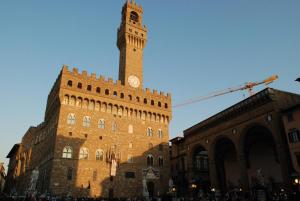
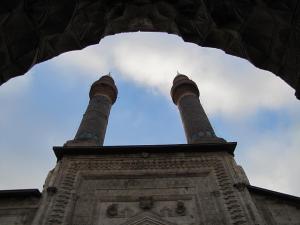 Although the historic context for urban design and subsequent history in Anatolia is quite different from that in North Africa and the Levant, there were consistencies in how buildings were used symbolically. For example, the portal of the Sifaiye Madrasa, a Seljuk building built in c.1217, was literally overshadowed by the larger Cifte Minerali Madrasa across the street, built later by Mongol rulers when they took control of Sivas in the 1270s. This is a terrific example of how power politics played out in stone, and is reminiscent of the competition between buildings in medieval Italy.
Although the historic context for urban design and subsequent history in Anatolia is quite different from that in North Africa and the Levant, there were consistencies in how buildings were used symbolically. For example, the portal of the Sifaiye Madrasa, a Seljuk building built in c.1217, was literally overshadowed by the larger Cifte Minerali Madrasa across the street, built later by Mongol rulers when they took control of Sivas in the 1270s. This is a terrific example of how power politics played out in stone, and is reminiscent of the competition between buildings in medieval Italy.
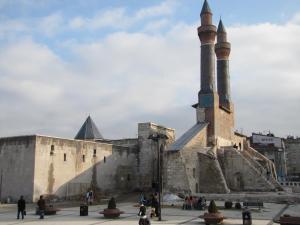
Felicity Ratté is professor of art history at Marlboro and author of Picturing the City in Medieval Italy. You can learn more about her research last year at http://cosmo.marlboro.edu/fratte/travel/.
Reconstructing Balkan Heritage
 Just when Felicity was winding down her travels, senior Colby Silver received a summer research grant for several weeks of fieldwork in Kosovo, Bosnia-Herzegovina and Dalmatia. In this region ravaged by war in the 1990s, Colby documented the destruction of architectural heritage and subsequent efforts to reconstruct and conserve historic buildings and sites. “Sadly, the use of heritage often does not become perceptible to the general population until it is lost or at risk of disappearing,” said Colby. His Plan of Concentration focuses on sites significant to specific communities, such as Ottoman mosques and Serbian monasteries, which were often targeted during the war. “Given the complex interwoven fabric of religious and ethnic groups in the Balkans, the region presents a particularly poignant and varied example of heritage valuation and loss.”
Just when Felicity was winding down her travels, senior Colby Silver received a summer research grant for several weeks of fieldwork in Kosovo, Bosnia-Herzegovina and Dalmatia. In this region ravaged by war in the 1990s, Colby documented the destruction of architectural heritage and subsequent efforts to reconstruct and conserve historic buildings and sites. “Sadly, the use of heritage often does not become perceptible to the general population until it is lost or at risk of disappearing,” said Colby. His Plan of Concentration focuses on sites significant to specific communities, such as Ottoman mosques and Serbian monasteries, which were often targeted during the war. “Given the complex interwoven fabric of religious and ethnic groups in the Balkans, the region presents a particularly poignant and varied example of heritage valuation and loss.”
